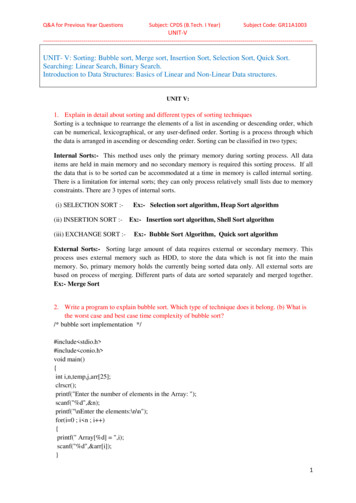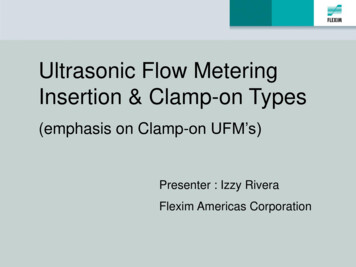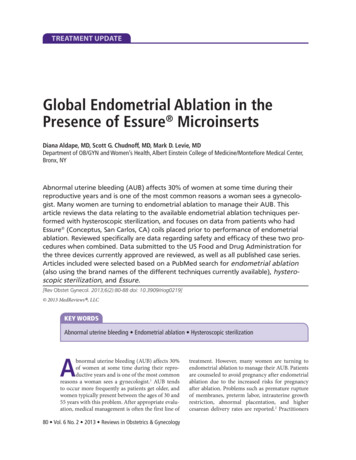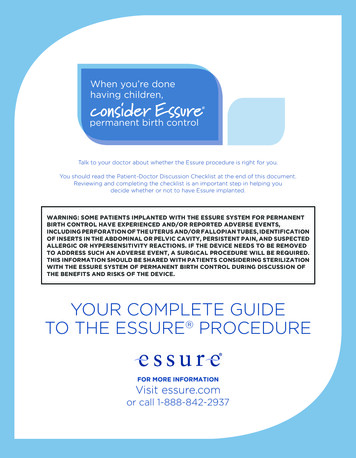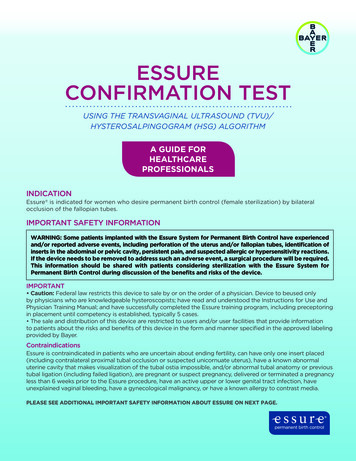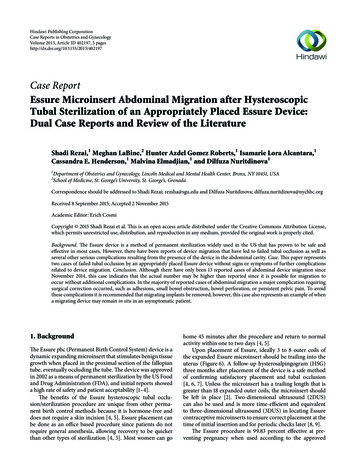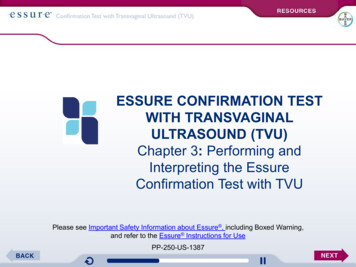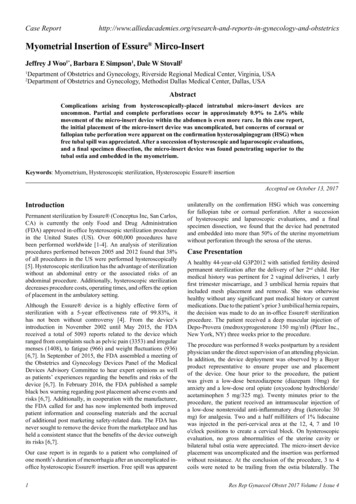
Transcription
Case reports-in-gynecology-and-obstetricsMyometrial Insertion of Essure Mirco-InsertJeffrey J Woo1*, Barbara E Simpson1, Dale W Stovall212Department of Obstetrics and Gynecology, Riverside Regional Medical Center, Virginia, USADepartment of Obstetrics and Gynecology, Methodist Dallas Medical Center, Dallas, USAAbstractComplications arising from hysteroscopically-placed intratubal micro-insert devices areuncommon. Partial and complete perforations occur in approximately 0.9% to 2.6% whilemovement of the micro-insert device within the abdomen is even more rare. In this case report,the initial placement of the micro-insert device was uncomplicated, but concerns of cornual orfallopian tube perforation were apparent on the confirmation hysterosalpingogram (HSG) whenfree tubal spill was appreciated. After a succession of hysteroscopic and laparoscopic evaluations,and a final specimen dissection, the micro-insert device was found penetrating superior to thetubal ostia and embedded in the myometrium.Keywords: Myometrium, Hysteroscopic sterilization, Hysteroscopic Essure insertionAccepted on October 13, 2017IntroductionPermanent sterilization by Essure (Conceptus Inc, San Carlos,CA) is currently the only Food and Drug Administration(FDA) approved in-office hysteroscopic sterilization procedurein the United States (US). Over 600,000 procedures havebeen performed worldwide [1-4]. An analysis of sterilizationprocedures performed between 2005 and 2012 found that 38%of all procedures in the US were performed hysteroscopically[5]. Hysteroscopic sterilization has the advantage of sterilizationwithout an abdominal entry or the associated risks of anabdominal procedure. Additionally, hysteroscopic sterilizationdecreases procedure costs, operating times, and offers the optionof placement in the ambulatory setting.Although the Essure device is a highly effective form ofsterilization with a 5-year effectiveness rate of 99.83%, ithas not been without controversy [4]. From the device’sintroduction in November 2002 until May 2015, the FDAreceived a total of 5093 reports related to the device whichranged from complaints such as pelvic pain (3353) and irregularmenses (1408), to fatigue (966) and weight fluctuations (936)[6,7]. In September of 2015, the FDA assembled a meeting ofthe Obstetrics and Gynecology Devices Panel of the MedicalDevices Advisory Committee to hear expert opinions as wellas patients’ experiences regarding the benefits and risks of thedevice [6,7]. In February 2016, the FDA published a sampleblack box warning regarding post placement adverse events andrisks [6,7]. Additionally, in cooperation with the manufacturer,the FDA called for and has now implemented both improvedpatient information and counseling materials and the accrualof additional post marketing safety-related data. The FDA hasnever sought to remove the device from the marketplace and hasheld a consistent stance that the benefits of the device outweighits risks [6,7].Our case report is in regards to a patient who complained ofone month’s duration of menorrhagia after an uncomplicated inoffice hysteroscopic Essure insertion. Free spill was apparent1unilaterally on the confirmation HSG which was concerningfor fallopian tube or cornual perforation. After a successionof hysteroscopic and laparoscopic evaluations, and a finalspecimen dissection, we found that the device had penetratedand embedded into more than 50% of the uterine myometriumwithout perforation through the serosa of the uterus.Case PresentationA healthy 44-year-old G3P2012 with satisfied fertility desiredpermanent sterilization after the delivery of her 2nd child. Hermedical history was pertinent for 2 vaginal deliveries, 1 earlyfirst trimester miscarriage, and 3 umbilical hernia repairs thatincluded mesh placement and removal. She was otherwisehealthy without any significant past medical history or currentmedications. Due to the patient’s prior 3 umbilical hernia repairs,the decision was made to do an in-office Essure sterilizationprocedure. The patient received a deep muscular injection ofDepo-Provera (medroxyprogesterone 150 mg/ml) (Pfizer Inc.,New York, NY) three weeks prior to the procedure.The procedure was performed 8 weeks postpartum by a residentphysician under the direct supervision of an attending physician.In addition, the device deployment was observed by a Bayerproduct representative to ensure proper use and placementof the device. One hour prior to the procedure, the patientwas given a low-dose benzodiazpene (diazepam 10mg) foranxiety and a low-dose oral opiate (oxycodone hydrochloride/acetaminophen 5 mg/325 mg). Twenty minutes prior to theprocedure, the patient received an intramuscular injection ofa low-dose nonsteroidal anti-inflammatory drug (ketorolac 30mg) for analgesia. Two and a half milliliters of 1% lidocainewas injected in the peri-cervical area at the 12, 4, 7 and 10o'clock positions to create a cervical block. On hysteroscopicevaluation, no gross abnormalities of the uterine cavity orbilateral tubal ostia were appreciated. The micro-insert deviceplacement was uncomplicated and the insertion was performedwithout resistance. At the conclusion of the procedure, 3 to 4coils were noted to be trailing from the ostia bilaterally. TheRes Rep Gynaecol Obstet 2017 Volume 1 Issue 4
Citation: Woo JJ, Simpson BE, Stovall DW. Myometrial Insertion of Essure Mirco-Insert. Res Rep Gynaecol Obstet. 2017;1(4):1-5patient tolerated the procedure well and was discharged homein good condition.Four months after the procedure, the patient had a routineconfirmation HSG. Assessment of the HSG revealed that the leftmicro-insert appeared to be properly placed in the left fallopiantube (Figure 1). In contrast, the right micro-insert had an acutecurvilinear appearance (Figure 1). As dye was injected, freespill was evident from the right side but the origin was unknown(Figure 2). The radiologist report stated the right fallopian tubewas not occluded and the right micro-insert was not containedwithin the right fallopian tube. The patient was scheduled forcounseling in regards to further assessment and managementwith presumption of a cornual or fallopian tube perforation.In an outpatient follow-up visit, the patient was advised toproceed with surgical management due to concerns for bowelinjury due to the device’s assumed peritoneal location. Thepatient reported that since her initial micro-insert placementshe had vaginal bleeding for one month but no pelvic pain. Thepatient was consented for hysteroscopy, diagnostic laparoscopy,right salpingectomy, and possible cornual resection. Due to thepatient’s strong desire to remove the entire foreign body, sherequested a total hysterectomy if needed. This was thoroughlydiscussed with her and she consented to a total laparoscopichysterectomy.On the day of her procedure, initial hysteroscopic evaluationrevealed 30-40 trailing coils extending from the right tubalostia (Figure 3). This was in contrast to the 3 to 4 trailing coilsappreciated after the initial insertion. The left tubal ostia wasclearly visualized with no micro-insert coils identified in theintrauterine cavity. Due to the length of the right-sided microinsert present within the uterine cavity, attempts were madeto release and retrieve the micro-insert using hysteroscopicoperative forceps. Resistance was appreciated and severalattempts to retrieve the micro-insert only expanded the coilswithout release of the device.At this point a diagnostic laparoscopy was deemed appropriateto assess the pelvis for uterine or tubal injury and to identifyboth micro-inserts. A complete pelvic survey was performedand no uterine or tubal perforations were identified. A rightsalpingectomy was completed due to the patient’s request ofpermanent sterilization and the fallopian tube was examinedwith no luminal position of the micro-insert. The right cornuawas thoroughly evaluated and there was no sign of the microinsert.Due to uncertainty of the micro-insert site, a secondhysteroscopic evaluation was performed. Several attemptsto remove the micro-insert from the right side by operativeforceps were again unsuccessful. Due to the patient’s requestFigure 1. HSG image displaying an acute curvilinear appearance of right micro-insert.Figure 2. HSG image displaying free-spill from right side with injection of dye.Res Rep Gynaecol Obstet 2017 Volume 1 Issue 42
Woo/Simpson/Stovallof removal of the entire foreign body, the previously discussedand consented total laparoscopic hysterectomy was performedwithout complication.The uterine specimen was removed and thoroughly examined.Grossly, as noted by diagnostic laparoscopy, there was noevidence of perforation of the uterine serosa by either microinsert. The uterine specimen was dissected in a midline coronalmanner superiorly from the cervix to the fundus and the devicewas found inserted superior to the right tubal ostia (Figures 4 and5). On further dissection, it was discovered that the device wasfirmly embedded through more than half of the myometrium(Figure 6).DiscussionThe mechanism of occlusion of the Essure mico-insert deviceincludes an inflammatory response of the fallopian tube tothe micro-insert. The inner coil is composed of stainless steeland polyethylene terephthalate (PET) fibers and the outer coilis composed of nickel-titanium (nitinol). The fallopian tubesinflammatory response to these materials causes fibroblasticgrowth within and around the double-coiled micro-insert toocclude the fallopian tube lumen [8].Bayer states that an Essure Confirmation Test (ECT) shouldbe completed 3 months after micro-insert device placement toverify correct bilateral placement and tubal occlusion [9,10].This confirmation test may be completed by either a HSG ortransvaginal ultrasound (TVU) [9,10]. A patient is eligible forTVU confirmation if the placement is uncomplicated withoutvisualization difficulties, there are no concerns of perforation,the procedure time is 15 minutes or less, 1-8 trailing coilsare apparent bilaterally, the patient is not on any activeimmunosuppressive therapy, and the post-operative course isuncomplicated [10]. In all other cases, an HSG is indicated.According to the HSG protocol, correct placement of the microinsert is based upon both tubal occlusion and location of both theinner and outer coil radiographic markers. Otherwise, placementis considered unsatisfactory for purposes of reliable sterilization[9]. A too proximal location occurs when 50% or more of theinner coil is trailing into the uterine cavity while a too distalinsert location occurs when the insert is in the tube with theproximal end of the inner coil 30 mm from the cornua [9]. Ifthe insert location is satisfactory but there is patency beyond thedistal end of the outer coil or free spill is appreciated, a repeatECT should be completed after an additional 3 months withalternative contraception during the interim [10].Figure 3. Thirty to forty trailing micro-insert coils visualized in uterine cavity during hysteroscopic evaluation.Figure 4. Midline coronal dissection displaying the micro-insert penetrating into the myometrium.3Res Rep Gynaecol Obstet 2017 Volume 1 Issue 4
Citation: Woo JJ, Simpson BE, Stovall DW. Myometrial Insertion of Essure Mirco-Insert. Res Rep Gynaecol Obstet. 2017;1(4):1-5Figure 5. Micro-insert penetrating superior to right tubal ostia.Figure 6. Micro-insert embedded into uterine myometrium without penetration through the uterine serosa.In this case report, although a TVU confirmation test was anoption, an HSG interpreted by a competent radiologist wasour confirmation test of choice. The HSG revealed no clearconcerns for a too proximal or distal insertion; however,because of free spill of contrast media from the right fallopiantube and an acute curvilinear appearance of the right-sideddevice, it was clear that the mico-insert was not placed inthe fallopian tube nor was the tube occluded. Four monthsafter the initial insertion, partial expulsion of the right microinsert had also occurred with 30-40 trailing coils noted in theintrauterine cavity on hysteroscopy. After dissection of theuterus, it was apparent that the right micro-insert device wasnot properly inserted into the fallopian tube, but was in factinserted into the myometrium.There are two critical clinical questions that arise from thiscase report. First, how was the right micro-insert insertedinto the myometrium without any suspicion of malposition?Second, what mechanisms explain the retrograde movementof the micro-insert from the right tubal ostia 4 months afterinsertion?Res Rep Gynaecol Obstet 2017 Volume 1 Issue 4Adenomyosis theoryIt is unclear exactly how the micro-insert was placedinto the myometrium. One theory is that the device wasnot catheterized through the tubal ostia, but perhaps intoa glandular-like opening or dimpling of adenomyosis.This might explain the lack of resistance at the time ofinsertion. Catheterization of a possible adenomyosis glandopening has been discussed in one case report that resultedin a likely cornual uterine perforation [11-13]. Commonhysteroscopic adenomyosis findings include the appearanceof several gland-like openings with and without blood aswell as hemosiderin deposits within the endometrium [14].In this case, the endometrial gland-like opening or dimplingfrom adenomyosis may have been misidentified as a tubalostium. Although the appearance of the endometriumin this patient suggests adenomyosis may be possible,hysteroscopy only detects adenomyosis in 10% to 20% ofcases and cannot determine focal versus extensive disease[14]. The final pathology diagnosis made no commentregarding adenomyosis.4
Woo/Simpson/StovallThe expulsion of 30-40 coils visualized in the uterine cavity 4months after insertion on the right side may be explained byrecoil from a dense, non-compliant myometrial tissue. Unlikethe compliant fallopian tube lumen, the myometrium’s densenon-complaint tissue likely rejected the device causing an initialpost-procedure partial expulsion and then a later fibroblasticinflammatory response resulting in myometrial embedding(Figure 6).There are several take-home points that one can learn from thisunusual case. First, due to the inflammatory properties of themicro-insert device, the more time the device is in place, themore difficult it will be to remove hysteroscopically. Second,removal of the Essure device requires the removal of boththe inner coil of stainless steel and polyethylene terephthalate(PET) fibers and an outer coil of nickel-titanium (nitinol).Third, when placing the device, it is imperative to have aclear visualization and identification of both tubal ostia priorto placement. This is especially important if there is a highsuspicion of adenomyosis. Hormonal medications may aid inhysteroscopic visualization during the procedure. Fourth, whilemost patients’ malpositioned micro-insert devices can presentwith pelvic pain, in this particular case, the only symptomwas menorrhagia. Lastly, if a malpositioned micro-insert issuspected, the patient’s desires regarding removal should bediscussed thoroughly. If necessary, a possible hysterectomyshould be considered and consented. While a hysterectomy isthe last resort for the removal of a malpositioned micro-insert, itmay be required for definitive management.ConclusionIn conclusion, to our knowledge, this is the first case to be reportedof an Essure micro-insert that has been identified embeddedinto myometrium without perforation through the serosa of theuterus. Management of an embedded myometrial micro-insertwithout perforation may be treated in a less invasive surgicalapproach, but it is difficult to determine the optimal treatmentbased on one case report. While our patient had only one monthof menorrhagia without pelvic pain, it is uncertain whether painmay have developed with time and eventually require furtherdefinitive surgical management. However, a total laparoscopichysterectomy was necessary in this particular case because ofthe patient’s request for removal of the entire device.2. Braginsky L, George S, Locher S. Management ofperforated Essure with migration into small and large bowelmesentery. J Minim Invasive Gynecol. 2015;22(3):504-8.3. Ricci G, Restaino S, DiLorenzo G, et al. Risk of Essuremicroinsert abdominal migration: case report and review ofliterature. Ther Clin Risk Manag. 2014;10:963-8.4. Garcia AL, Lewis RM, Sloan AL. Essure insert expulsionafter 3-month hysterosalpingogram confirmation of bilateraltubal occlusion and bilateral correct placement: Case report.J Minim Invasive Gynecol. 2013;20(1):107-11.5. Conover M, Howell J, Wu J, et al. Incidence of opioidmanaged pelvic pain after hysteroscopic sterilizationversus laparoscopic sterilization, U.S. 2005-2012.Pharmacoepidemiol Drug Saf. 2015;24(8):875-84.6. U.S. Food And Drug Administration. Meeting Materials ofthe Obstetrics and Gynecology Devices Panel. 2015.7. U.S. Food And Drug Administration. FDA Activities:Essure. 2017.8. Veersema S, VIeugels M, Koks C, et al. Confirmation ofEssure placement using transvaginal ultrasound. J MinimInvasive Gynecol. 2011;18(2):164-8.9. 0113d ect process for e-use.pdf10. 11. Thoma V, Chua I, Garbin O, et al. Tubal perforationby ESSURE microinsert. J Minim Invasive Gynecol.200;13(2):161-3.12. Glasser MH. Tubal perforation by ESSURE microinsert:A tubal perforation? J Minim Invasive Gynecol.2006;13(5):487.13. Valle RF. Tubal peroration by ESSURE microinsert: Clearlynot a tubal peroration but cornual-uterine perforation. JMinim Invasive Gynecol. 2008;13(5):487-88.14. Bradley, Linda D, Tommaso F. Indications andcontraindication for office hysteroscopy. Hysteroscopy:Office Evaluation and Management of the Uterine Cavity.Mosby/Elsevier, Philadelphia, 2009.References1. Al-Safi Z, Shavell V, Hobson D, et al. Analysis of adverseevents with Essure hysteroscopic sterilization reportedto the manufacturer and user facility device experiencedatabase. J Minim Invasive Gynecol. 2013;20(6):825-29.5*Correspondence to:Jeffrey J WooDepartment of Obstetrics and GynecologyRiverside Regional Medical CenterVirginiaUnited States of AmericaE-mail: Jeffrey.Woo@rivhs.comRes Rep Gynaecol Obstet 2017 Volume 1 Issue 4
Bayer states that an Essure Confirmation Test (ECT) should be completed 3 months after micro-insert device placement to verify correct bilateral placement and tubal occlusion [9,10]. This confirmation test may be completed by either a HSG or transvaginal ul
